Patagonia, Monday, December 22, 2025




- Espaņol
- English
Paleontology
Patagonian Dinosaurs

In the Argentinian Patagonia, there have been great discoveries in the paleontology field. Here we mention the most outstanding finds:
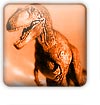 |
Giganotosaurus CAROLINII The "CAROLINII", considered the largest carnivorous dinosaur in the world, surpasses the famous Tyranosaurus Rex in size. It was discovered in July, 1993, by Rubén Darío Carolini, present Director of the Villa El Chocón Municipal Museum, in a former lagoon located 18 km to the South of Villa El Chocón. 80% of the fossil material of this specimen has been rescued and is preserved in optimum condition. This carnivore, with reduced fore limbs, biped gait and with three toes in each leg, would measure 13.5 m of length and its hip could reach 4.6 m. It is estimated that it would weigh 9,500 kg when it was alive. Its head would measure 2 m and its longest tooth, 21 cm. This specimen belongs to the Mid Cretaceous from the Mesozoic Era and it dwelled the Plaza Huincul area 90 million years ago. |
||
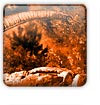 |
Argentinosaurus Huinculensis Named Huinculensis after the district of Plaza Huincul where its fossil remains were found, in the Province of Neuquen. This is the largest herbivorous dinosaur found so far. Its size is even larger than the "Carolinii", which was a carnivore. It belongs to the Mid Cretaceous period. It is estimated that it is 98 million years old. It was rescued by the staff of the Carmen Funes Museum in Plaza Huincul, where original pieces of the find are exhibited. This is a great sauropod, some of its dorsal vertebras are the largest ever recorded. They are 1.70 meters high. |
||
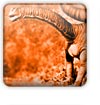 |
Andesaurus Delgadoi In 1987, a campaign organized by the Comahue National University extracted some vertebras and part of the hip of a dinosaur that was later called ANDESAURUS DELGADOI (after its discoverer Alejandro Delgado). It was found several meters under the waters of Lake Exequiel Ramos Mejía (lake formed by the El Chocón Dam). The rescue took place when the level of the lake went lower than its historical records. It is estimated that it was 15 meters long. At present, it is exhibited at the Comahue National University Geology and Paleontology Museum. |
||
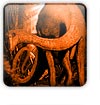 |
Rebbachisaurus Tessonei In 1988, the most complete specimen in South America was found in Villa El Chocón. It was called REBBACHISAURUS TESSONEI. This is a sauropod, herbivorous middle-sized dinosaur, which would weight about 10,000 kilos and measure 17 meters of length. Nowadays, it is exhibited at the Geology and Paleontology Museum. In turn, the rebbachisaurus tessonei was one of the favourite dishes of the largest carnivore of all times -the Giganotosaurus carolinii. According to experts Jorge Calvo and Leonardo Salgado, these huge animals with very long tails and necks would wander about the area on their four legs over one hundred million years ago, devouring the exuberant vegetation that would cover the marshlands. |
||
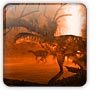 |
Gasparinisaura Cincosaltensis Found recently, this herbivorous dinosaur stood out for its small size (1.50 m.). It was graceful and very fast. According to speculations made by scientists, it would live in groups, as several specimens (adults, youths and offspring) were found within a 100m2 area. It dates back from the Upper Cretaceous, approximately 90 million years ago. |
||
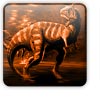 |
Carnotaurus Sastrei With 10m of length and 4m of height, it belonged to the most spectacular group of South American carnivorous dinosaurs: the Abelisauridae. It had horns in its head and very small fore limbs, almost atrophiated. It lived 90 million years ago, during the Upper Cretaceous. |
||
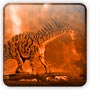 |
Amargasaurus Cazaui This herbivorous dinosaur had remarkably long forked vertebral spines, especially on the back of its neck. The specimen exhibited in the museum is 9 m long. This is more ancient than the dinosaurs mentioned above. It is 130 million years old and dates back from the Lower Cretaceous. |
||
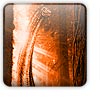 |
Titanosaurus Australis This is one of the sauropod dinosaurs that has been most thouroughly studied. It did not surpass the 8 m of length, although other representatives of its family (also exhibited in the museum) would loosely surpass this measure. Almost spherical fossil eggs of these animals have been found. One of these eggs belongs to the collection of the museum and may be observed by visitors. This dinosaur stepped on Patagonia approximately 85 million years ago, during the Upper Cretaceous. |
||
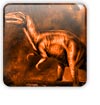 |
Piatnitzkysaurus Floresi With 5 m of length, it was an active hunter that would probably attack the sauropod dinosaurs, especially the young, in groups. Its large and curved claws were used in hunting as a complement of its formidable teeth. It dwelled the area during the Mid Jurassic, 165 million years ago. |
||
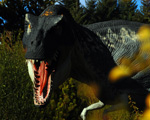
In the Name of Science
In some cases, dinosaurs are named after their discoverer or the paleontologist who determines that the specimen belongs to a new genus. Some other times, nomenclatures refer to some phyiscal trait or to the site where the dinosaur remains were found. At any rate, the name must be approved by the International Comission on Zoological Nomenclature.Nowadays, there are several paleontological research teams performing excavations in Patagonia: the Comahue National University paleontology museum team, led by Jorge Calvo; the Carmen Funes Municipal Museum team from Plaza Huincul, conducted by Rodolfo Coria; and the Ernesto Bachman Museum from El Chocón, guided by Edith Simón.
Inter Patagonia - Information on paleontology and dinosaurs in Patagonia
© InterPatagonia 2002-2025 Total or partial reproduction forbidden. Derechos de Autor 675245 Ley 11723
© InterPatagonia 2002-2025 Total or partial reproduction forbidden. Derechos de Autor 675245 Ley 11723